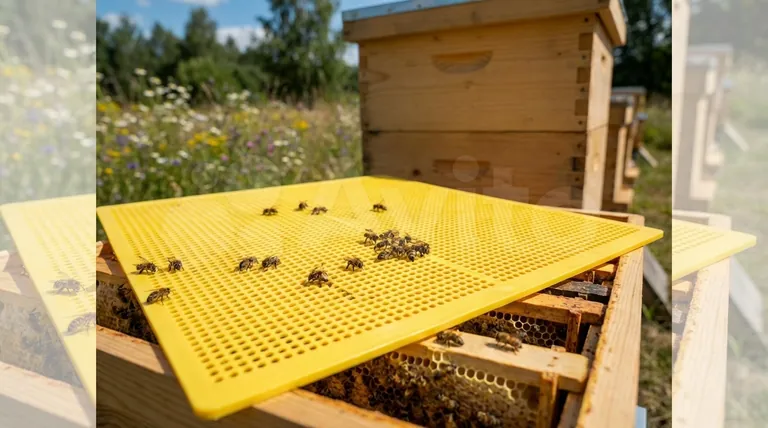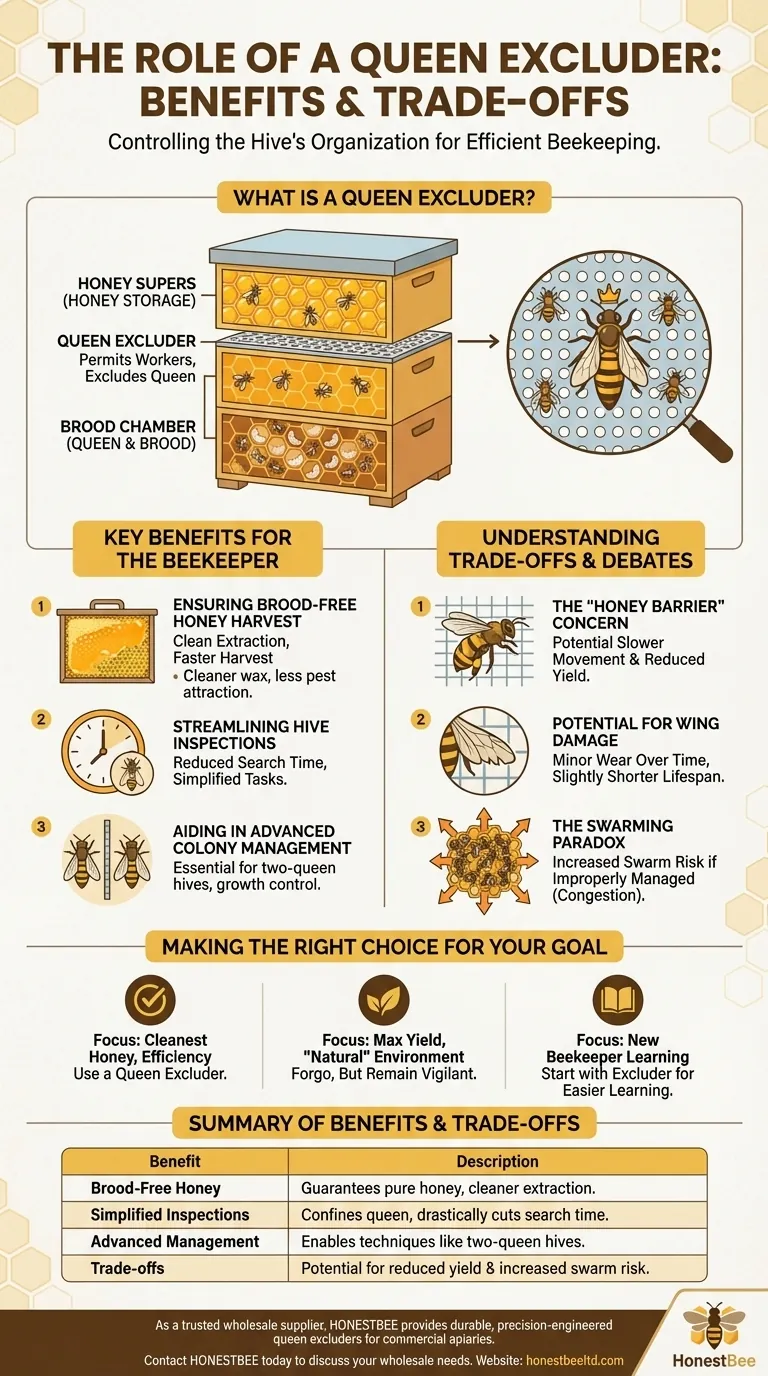At its core, a queen excluder is a management tool designed for one primary purpose: to control where the queen bee can lay her eggs. By placing a specialized grid between the brood chamber and the honey storage boxes (supers), beekeepers can prevent the larger queen from moving into the honey supers while allowing the smaller worker bees to pass through freely. This ensures honey supers remain dedicated solely to honey storage.
A queen excluder is a tool of control. It simplifies honey harvesting and hive inspections by creating a clear division between the hive's "nursery" and its "pantry," but this control comes with trade-offs that can impact hive productivity and behavior.

The Core Principle: A Well-Organized Hive
A hive operates with remarkable efficiency. A queen excluder leverages and enforces this natural organization for the beekeeper's benefit.
What is a Queen Excluder?
A queen excluder is a flat screen, typically made of metal wire or plastic. The gaps in the screen are precisely engineered to be large enough for worker bees to pass through but too small for the larger-bodied queen (and drones).
It is placed directly on top of the uppermost brood box, creating a ceiling the queen cannot penetrate. Any boxes placed above it—the honey supers—are thereby designated as a brood-free zone.
Confining the Queen to the Brood Chamber
By restricting the queen to the lower boxes, you ensure the brood nest (where eggs, larvae, and pupae are raised) remains contained. This creates a clear and predictable structure within the hive: brood below, honey above.
This separation mimics the bees' natural tendency to store honey above and around the brood nest, but it makes that division absolute.
Key Benefits for the Beekeeper
Using an excluder introduces a level of predictability and convenience that many beekeepers find invaluable, especially when it comes time to harvest honey.
Ensuring a Brood-Free Honey Harvest
This is the most significant benefit. When you pull frames from a honey super that has been protected by an excluder, you are guaranteed to find only honey and pollen.
You will not find frames filled with eggs or developing larvae. This makes the extraction process cleaner, faster, and prevents the accidental destruction of the next generation of bees. It also results in cleaner wax, as it hasn't been used for brood rearing, which can make it less attractive to pests like wax moths.
Streamlining Hive Inspections
Finding the queen is a critical task during hive inspections. Without an excluder, you might have to search for her across twenty or more frames spread throughout multiple boxes.
With an excluder, you know she is confined to the brood chamber, drastically reducing your search area. This saves time, reduces stress on the colony, and makes tasks like requeening much simpler.
Aiding in Advanced Colony Management
Excluders are also essential tools for more advanced beekeeping techniques. They are used in systems like two-queen hives to keep the queens separate or to temporarily confine a queen to a single box to manage colony growth and temperament.
Understanding the Trade-offs and Debates
A queen excluder is not a universally adopted tool, and for good reason. Objective analysis requires understanding the potential downsides.
The "Honey Barrier" Concern
Some beekeepers believe that the excluder acts as a "barrier" that slows down worker bees. The argument is that forcing fully-loaded foragers to squeeze through the grid repeatedly can reduce their efficiency and, ultimately, the overall honey yield. This has led some to call it a "honey excluder."
Potential for Wing Damage
The constant passage through the metal or plastic grid can cause physical wear on the worker bees' wings. While a minor issue for any single bee, over the life of the colony, this can contribute to a slightly shorter worker lifespan.
The Swarming Paradox
An excluder can complicate swarm management. If the brood chamber becomes overcrowded with brood and honey (a condition called "honey-bound"), the queen runs out of space to lay. Normally, she might move up, but the excluder prevents this.
This congestion is a primary trigger for swarming. By trapping the queen in a crowded space, an improperly managed excluder can increase swarm risk rather than prevent it.
When an Excluder is Unnecessary
In many hive configurations, especially those that use multiple deep boxes for the brood chamber, an excluder is often not needed. The queen will have ample space to lay, and the bees will naturally store surplus honey in the uppermost boxes, creating a natural separation without a physical barrier.
Making the Right Choice for Your Goal
The decision to use a queen excluder depends entirely on your beekeeping philosophy and operational goals.
- If your primary focus is harvesting the cleanest possible honey with maximum efficiency: Use a queen excluder to guarantee brood-free supers and simplify the extraction process.
- If your primary focus is maximizing potential honey yield and a more "natural" hive environment: Forgo the excluder but remain vigilant to ensure the queen doesn't move up before the harvest.
- If you are a new beekeeper learning hive management: Start with a queen excluder to make finding the queen and understanding the hive's structure much easier.
Ultimately, the queen excluder is a tool, and its value is determined by how thoughtfully it is applied to solve a specific problem.
Summary Table:
| Benefit | Description |
|---|---|
| Brood-Free Honey | Guarantees honey supers contain only honey, making extraction cleaner and faster. |
| Simplified Inspections | Confines the queen to the brood chamber, drastically reducing search time. |
| Advanced Management | Essential for techniques like two-queen hives or controlling colony growth. |
| Trade-offs | Potential for reduced honey yield and increased swarm risk if not managed properly. |
Ready to simplify your hive management and harvest cleaner honey?
As a trusted wholesale supplier to commercial apiaries and beekeeping equipment distributors, HONESTBEE provides the durable, precision-engineered queen excluders and other essential supplies you need to operate efficiently at scale. Our equipment helps you maximize productivity and ensure consistent, high-quality results.
Contact HONESTBEE today to discuss your wholesale needs and discover how our beekeeping solutions can benefit your operation.
Visual Guide

Related Products
- Professional Plastic Queen Excluder for Modern Beekeeping
- Wooden Queen Bee Excluder for Beekeeping
- High Performance Plastic Queen Excluder for Beekeeping and Apiary Management
- Premium Wood Framed Metal Wire Queen Bee Excluder
- Plastic Queen Bee Excluder for Bee Hive Wholesale
People Also Ask
- What is the primary function of a queen excluder in beekeeping? Control Hive Layout for Efficient Honey Harvesting
- What is a Queen Excluder and how does it work? Achieve Purer Honey & Better Hive Control
- How does a queen excluder work? Master Hive Management for Pure Honey Harvests
- What is the purpose of a queen excluder when adding a super? Streamline Your Honey Harvest
- What is the role of a queen excluder when adding a super? Ensure Brood-Free Honey Harvests



















